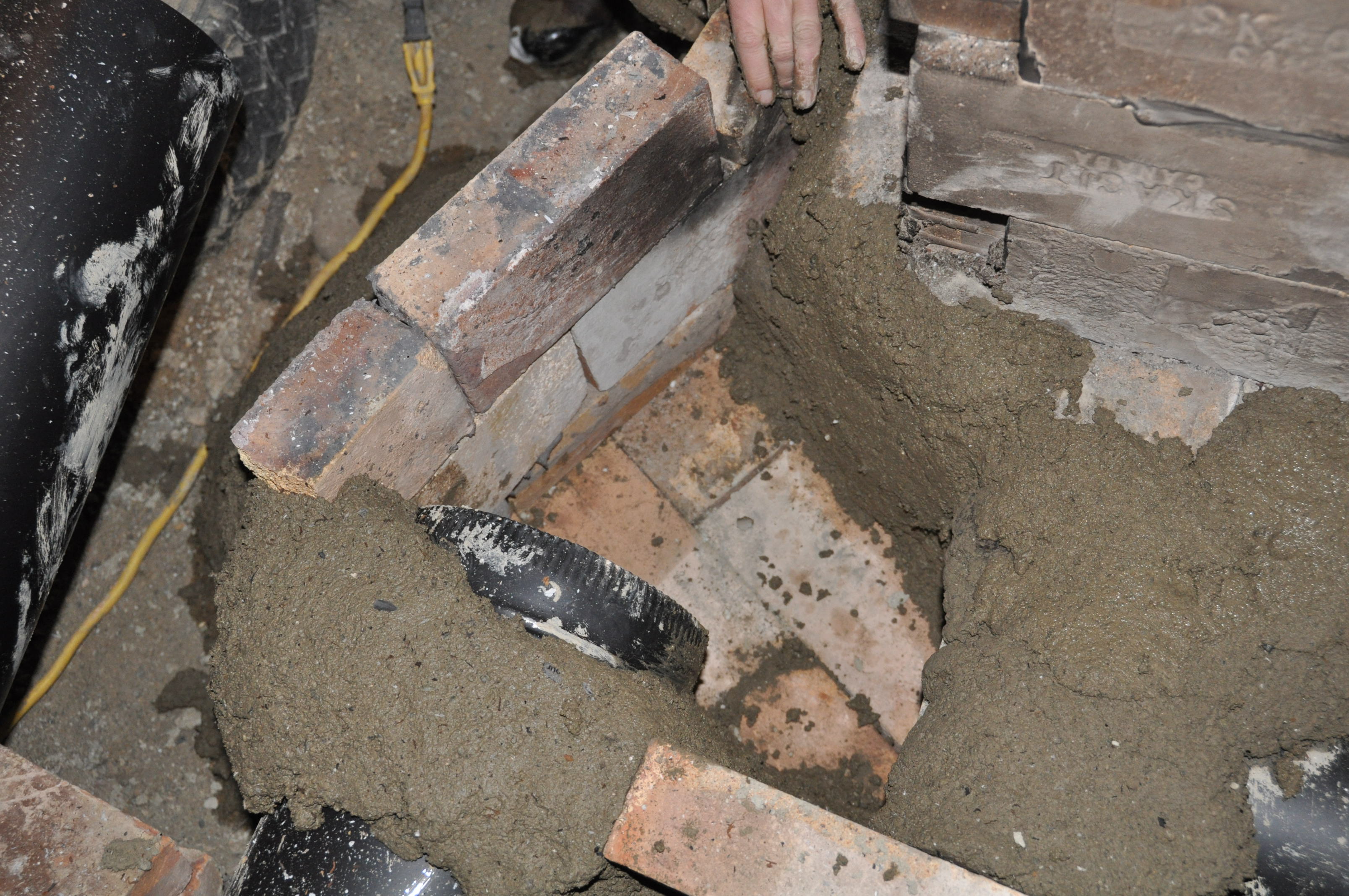
We have had a busy couple of days, and I noticed this evening that I have not posted in the last couple of days.
At some point yesterday afternoon we had the exhaust for the stove completely hooked up; 6′ of double walled chimney starting 3′ above the roof continuing through it and ending 2′ below the ceiling, 6′ of vertical single wall stove pipe and 17′ of horizontal heat exchange pipe starting at the stove manifold. Once we had everything reasonably secure we fired up the rocket mass heater … and it worked! As Sandra commented, ‘Don’t know if its working properly, but after all that at least we can say we got it built.’ Small victories …
I am trying to keep a fairly detailed account of our stove construction so lets see if I can bring it up-to-date …
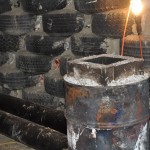 We filled the space between the heat riser and the insulation barrel with a clay slip/perlite mix (1 part slip: 9 parts perlite). We made sure that the perlite filled all the voids to the top of the barrel. We then formed a thermal cob cap on top of this insulation. The cap has two purposes; it prevents the insulation from escaping, and its sloped shape helps to avoid ash buildup at the top of the heat riser. Our cap slopes down towards the outside of the heat barrel as this worked the best for our setup … however this means that ash will tend to fall towards the manifold and around the outer edge of the heat riser barrel.
We filled the space between the heat riser and the insulation barrel with a clay slip/perlite mix (1 part slip: 9 parts perlite). We made sure that the perlite filled all the voids to the top of the barrel. We then formed a thermal cob cap on top of this insulation. The cap has two purposes; it prevents the insulation from escaping, and its sloped shape helps to avoid ash buildup at the top of the heat riser. Our cap slopes down towards the outside of the heat barrel as this worked the best for our setup … however this means that ash will tend to fall towards the manifold and around the outer edge of the heat riser barrel. 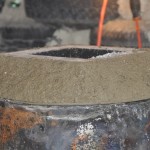 If possible it is recommended that you slope this cap in towards the centre of the burn tube, encouraging the ash to fall back into the core of the stove. The reason for this is simple, it is easier to clean out the heat tunnel, than the manifold and barrel perimeter.
If possible it is recommended that you slope this cap in towards the centre of the burn tube, encouraging the ash to fall back into the core of the stove. The reason for this is simple, it is easier to clean out the heat tunnel, than the manifold and barrel perimeter.
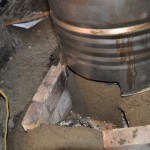 We fitted the heat riser barrel in place. The bottom of the barrel sits on top of the heat exchange tunnel, giving it a very secure seat on that side of the barrel. At the two sides of the stove we placed additional bricks to support both the insulation and heat riser barrels. This side support was a little tricky, you do not want these bricks to interfere with sculpting a ring between the bases of the two barrels for the exhaust gas to flow through. We cut an opening at the base of the barrel where it meets the manifold to ensure that there was no constriction for the exhaust gas (the opening into the manifold was slightly more than the 49 square inches that is the cross sectional area of the throat of the stove). I am glad we used a stainless steel barrel for the heat riser; it looks attractive, and will look better when we clean it up after we are done.
We fitted the heat riser barrel in place. The bottom of the barrel sits on top of the heat exchange tunnel, giving it a very secure seat on that side of the barrel. At the two sides of the stove we placed additional bricks to support both the insulation and heat riser barrels. This side support was a little tricky, you do not want these bricks to interfere with sculpting a ring between the bases of the two barrels for the exhaust gas to flow through. We cut an opening at the base of the barrel where it meets the manifold to ensure that there was no constriction for the exhaust gas (the opening into the manifold was slightly more than the 49 square inches that is the cross sectional area of the throat of the stove). I am glad we used a stainless steel barrel for the heat riser; it looks attractive, and will look better when we clean it up after we are done.
We had a little bit of work left on the manifold. We finished cobbing around the bricks that formed the manifold and gave the cob some time to set. We did not want to fire up the stove again until we had the exhaust properly vented outside … two days of test runs were making the house and us smell like a campground. I used the bottom that I cut from the stainless steel stove barrel to form a ‘roof’ for the manifold. I cut this roof to fit snugly to the edge of the barrel and to conform to the shape of the manifold. When I installed this roof I left a small gap (about 1/8″) between the barrel and the roof to allow for expansion and contraction. We then cobbed around this roof and the base of the heat riser barrel to seal the stove.
We were now ready to get the stove exhausted outdoors. Many rocket stoves are vented horizontally out the side of the building; the flue exit temperature is quite low (100-200 degrees F) so there is not the fire risk of a conventional chimney, and a vertical flue takes away from the length of pipe in the heat exchanger. The established ‘rule-of-thumb’ for a rocket mass heater using an 8″ diameter flue is that the combined length of the flue and heat exchanger should not exceed 30′ (ours works out to 29′), or there is not enough ‘push’ for the exhaust. In our system the flue is 12′ long so our heat exchange distance was ‘limited’ to around 18′. The consequence of this is that our flue temperature may be slightly ‘high’ as our heat exchanger is shorter than desired … we will lose some heat up our flue. We chose a vertical flue simply because it is conventional and we are building this stove under a building permit. We felt this decision made the stove easier to permit.
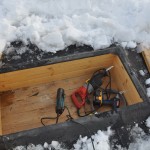 The first step we took to get the exhaust installed was to cut a hole in the roof. This always makes me nervous after all the work that went into making the roof! We built a box on the roof deck before we insulated the roof around where we thought we wanted the stove. The roof insulation butts up to the outside of the box leaving a 2’x4′ square where there is only roof decking. I cut a 12″ diameter hole through the roof deck and fitted the 12″ diameter bucket that came with the insulated chimney pipe. The bucket simply creates an air space around the chimney pipe where it passes through the roof cavity. This space must be kept clear to minimize fire risk.
The first step we took to get the exhaust installed was to cut a hole in the roof. This always makes me nervous after all the work that went into making the roof! We built a box on the roof deck before we insulated the roof around where we thought we wanted the stove. The roof insulation butts up to the outside of the box leaving a 2’x4′ square where there is only roof decking. I cut a 12″ diameter hole through the roof deck and fitted the 12″ diameter bucket that came with the insulated chimney pipe. The bucket simply creates an air space around the chimney pipe where it passes through the roof cavity. This space must be kept clear to minimize fire risk. 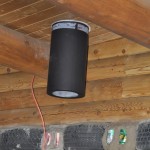 Our bucket is approximately 3′ long and extends almost 2′ below the ceiling. We did this to ensure that we met the clearance requirements of chimney pipe from combustible surfaces (in our case our 2×6 ceiling deck, log rafters and beams). Single wall chimney pipe must be kept 18″ from combustible surfaces. Unfortunately, we did not work out our distances perfectly and will need to install a heat shield between the wooden beams at the top of our wall and the chimney.
Our bucket is approximately 3′ long and extends almost 2′ below the ceiling. We did this to ensure that we met the clearance requirements of chimney pipe from combustible surfaces (in our case our 2×6 ceiling deck, log rafters and beams). Single wall chimney pipe must be kept 18″ from combustible surfaces. Unfortunately, we did not work out our distances perfectly and will need to install a heat shield between the wooden beams at the top of our wall and the chimney.
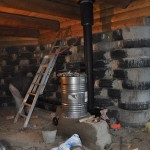 Once the bucket was in place it was a fairly simple matter to hook up the balance of the exhaust flue. Six feet of double-walled insulated chimney pipe was installed starting at the bottom of the bucket and exiting out through the roof.
Once the bucket was in place it was a fairly simple matter to hook up the balance of the exhaust flue. Six feet of double-walled insulated chimney pipe was installed starting at the bottom of the bucket and exiting out through the roof. 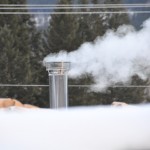 Single wall stove pipe was then attached to the bottom end of the insulated pipe and connected to the heat exchange pipe already in place. With everything in place we lit the stove!
Single wall stove pipe was then attached to the bottom end of the insulated pipe and connected to the heat exchange pipe already in place. With everything in place we lit the stove!
Initial results are promising; the stove was fairly easy to light (I’ve read of some problems at this stage), and a horizontal flame was quickly established. We put a clean out at the base of the flue and made sure the flue was close to the feed barrel of the stove. This allows us to light a piece of paper and stick it in the base of the flue to encourage the stove to draw properly when first lit … it is very effective. For the last day or so the stove has been drying out … it is mesmerizing to watch the steam curl off of the stove. Frustratingly, I do not have any way to take temperature readings at the top of the burn barrel or the exhaust flue (an almost intolerable situation!), so I have no idea how well the stove is performing. The barrel is quite hot … you cannot touch it! The exhaust temperature is quite low … you could lean against the flue and feel pleasantly warm. The exhaust coming out of the chimney is clear once the fire is established, it smokes at start up. I am going to see about some sort of thermometer …
Some thoughts and observations …
The top of our heat riser barrel is 2-3/8″ above the top of the heat riser. The Rocket Mass Heater book specifies a minimum distance at this point of 1.5″, but there is some latitude to increase this distance according to other builders. The tighter this measurement is, the hotter the top of the barrel will get and the quicker water will boil for tea. Practically, there seems to be a sweet spot that optimizes the performance of the stove. I am not sure if I should play with this gap and hunt for a sweet spot and how I would go about doing that?
The gap between the insulation barrel and the heat riser barrel is 1.5″ and this is the distance specified by the Rocket Mass Heater book.
We got a carbon monoxide detector and put it in the same room as the stove. It has not moved off of a reading of 0 ppm. It occurs to me as I type this that I should go stick it at the outlet of the chimney and see what it reads.
We have not yet
- built our cob bench,
- finished insulating around the stove,
- installed the feed barrel
- provided an outside source of combustion air
So much to do! All of these steps will improve the effectiveness of the stove so I am keen to carry on.
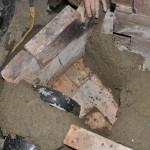
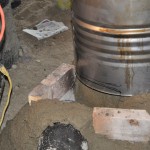
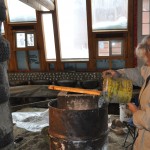
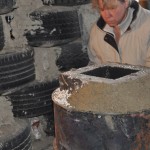
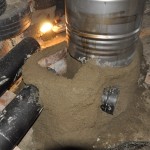
Hello again,
For the temperature at the top of the barrel, the best compromise I found, was to use one of these thermometer. Look at the last photo down the page.
If you find something more suitable, I’d be glad to hear about it!
Yvan